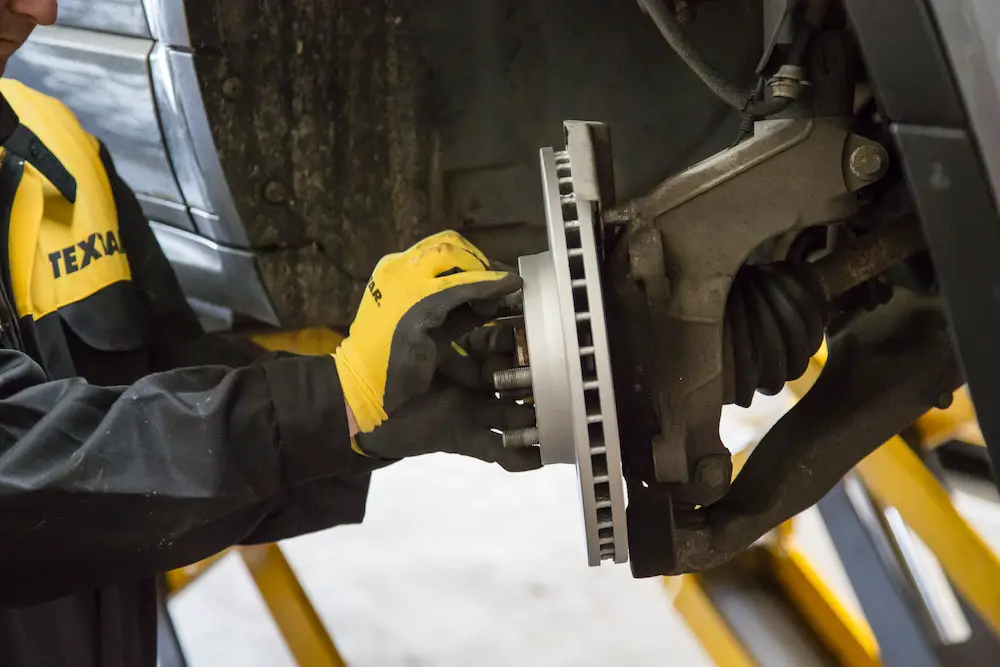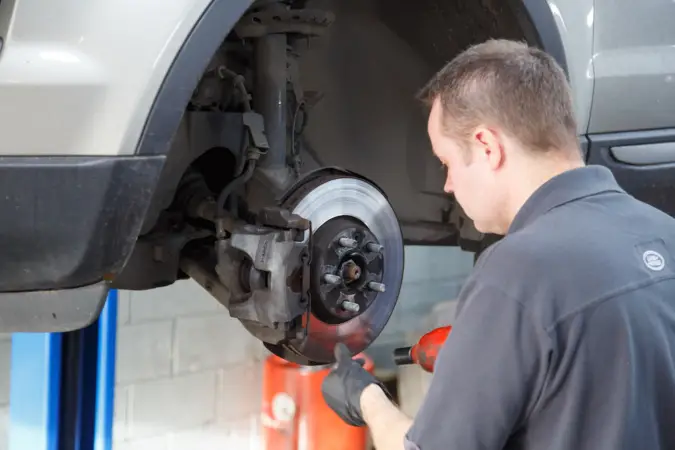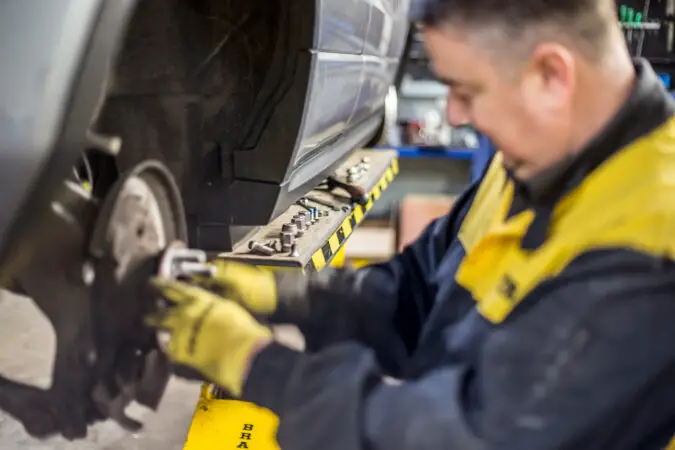Are you experiencing some weird popping or clicking noises from the wheel hub assembly while turning? Then, in this case, you might be suffering from a broken CV axle. If you seriously thinking this, then you are at the right place because there will be a lot to cover on this topic.
Having a problem like this can be really frustrating to deal with. Namely, because this axle is basically holding your front wheel in check and transfers all of the power from the transaxle to the wheel. Without this CV joint being in good condition, you will definitely feel the downsides of this action sooner or later.
That’s why you need to improve your troubleshooting skills and gain some knowledge when it comes to the problem of a broken axle. You need to understand its method of action to be able to determine the root of the problem and how to sort this issue as soon as possible. But you shouldn’t worry because we are going to help you out with that.
First, we will learn what is this axle all about. Then we will cover the broken CV axle and we will learn why this problem happens in the first place. Then we will cover the bad CV axle symptoms and how to diagnose them. After, we will focus on the CV axle repair and CV axle replacement. So, if you want to learn more, follow along till the end because there will be a lot to cover on this topic.
What Is A CV Axle?
So, what is a CV axle in general terms? Knowing this is extra useful if you want to dive deeper and understand the reasons and symptoms behind this problem. First, you need to understand what this component really is and what work is doing in your car. If you feel that you are up to the task, you can move to the bad CV axle symptoms. If not, keep up with us for a while while we cover the basics.
The CV axle is a constant velocity joint axle. This is basically a drive axle that transfers the power from the transaxle to the wheels.
What is different with the constant velocity joint is that this joint is very flexible. Meaning that it is extremely adjustable when it comes to different situations on the road.
The core of the CV joint is a steel ball that is installed under a rubber boot. This is a rather complex mechanism that is composed of six spheres that are bounded to one anti-fall gate. This anti-fall gate basically prevents the spheres from falling out and keeps them perfectly aligned.
This allows this type of joint to be extremely flexible and adapt to the conditions on the road. So, if there is a pothole, the suspension only dives, not the whole body of the vehicle.
With solid axles like the ones uses in the past, there was no flexibility and the comfort inside of the cabin was very poor. These axles are doing miracles for us every day. But they can break and you will end up with a broken CV axle, why does it happen? Let’s see up next.
Broken CV Axle Why It Happens, CV Axle Boot?
Now let’s cover more on the causes of a broken CV axle, let’s learn what causes this axle to break and cause you trouble. In fact, there are two main causes for this situation happening and in the next paragraphs, we are going to cover both of them.
The first reason why the broken CV axle happens is because of normal wear and tear. As you probably know, your suspension is facing obstacles on a daily basis. Meaning that this suspension is doing all the hard work to keep your car driving.
The mechanism that is inside of this axle also known as a constant velocity joint, tends to fail. It will start to wear down and your joint will develop play inside of it. The more play inside of the joint. The worse the symptoms will be and the worse the problem. But there is something that speeds up the deterioration of the joint and that is the CV axle boot.
This is the second thing that could ruin your joint and also a more probable reason why the axle will fail. The rubber boot that is around your CV joint will age and start to decompose. Then there will be cracks on this boot and basically, this boot will allow the debris that you encounter to enter this mechanism.
The more debris that enters inside of this constant velocity joint, the worse the situation will be. The grease that is inside of the joint will leak out, leaving the metal to rub against metal and this will be detrimental for your axle. Without proper lubrication, you will not be able to maintain the overall health of the axle and the axle will start to develop bad CV axle symptoms.
Bad CV Axle Symptoms
Now as we covered the basics of the CV axle and the causes for a broken CV axle, let’s now focus more on the bad CV axle symptoms.
As you probably know, every component when it breaks down starts to develop a ton of symptoms. Some of them are more and some of them less.
What is good, is that you can detect this problem when it first appears. You only need to train your troubleshooting skills and you will be able to tell right away that something is wrong.
And we are going to help you out with that by covering the main symptoms in the following chapters. So, if you want to learn more, follow along.
1. Grease Sports On The Sidewall
The first in our list of bad CV axle symptoms is the situation when the grease leaks on the sidewall of the tire. If you notice this odd leak, then you clearly have a problem with the CV joint.
When the rubber boot deteriorates, it will start to leak right where the sidewall is located. The tire will be all greasy as well as there will be grease spots on the ground.
And you should not ignore this situation at any cost. In fact, this is a really good time to repair the joint. If you detect this problem on time, you will be able to replace this rubber boot only and apply fresh grease inside of the CV joint.
Unfortunately, not a lot of owners detect this problem on time and wait long enough for the situation to get worse and the CV joint to deteriorate.
The more you wait when it comes to this stuff, the worse. If you wait long enough, you will not be able to repair the joint. The only solution will be to replace it. And this is rather an expensive thing to do. So, beware of these symptoms. Now let’s move to the next symptom.
2. Damaged Rubber Boot
The second in our list of bad CV axle symptoms that a lot of people miss is the damaged rubber boot of the CV joint. Almost nobody inspects the condition of these CV joints. All of the owners are alerted only after the damage is done. And that is when there is enough debris inside of the rubber boot to ruin the CV joint.
That’s why you should not be one of these owners and you should make sure that you check the condition of these boots every now and then.
Giving them a proper inspection will certainly guarantee that you will never have the issue of a bad CV axle. And inspecting them is a fairly simple process.
The only thing you will need to do is to fully turn the steering wheel to the left or right and inspect the boots on both of the wheels.
Sometimes even removing the wheel helps for this situation to be avoided. Giving a proper check on your suspension components will save you thousands of dollars in the long run.
I’m telling you this because a new rubber boot is only a fraction of the price in comparison to a new CV axle. This is why knowing the symptoms is really essential. Now let’s move to the next symptom.
3. Popping Or Clicking Noise When Decelerating, Turning And Driving Over Potholes
The third in our list of bad CV axle symptoms is the popping, clunking, or clicking noise. This noise will be the most notable symptom that this problem develops. Noises can also be caused by bad control arm bushings as well. So, beware of them too. But the most common reason is the CV joint.
Whenever there is debris in this joint, the joint will slowly start to degrade. And as the problem becomes larger and larger, you will notice how sounds are starting to develop while you drive your car.
These sounds will be most notable whenever you go over potholes or over curbs. Also, whenever you make a turn. There will be popping noises from the front end whenever you try to turn the wheel over.
You might notice how something literally will fall apart anytime soon. A very unpleasant sign. And it could fall apart if this problem is not sorted on time. The joint will separate into two pieces and the wheel will crumble inside of the wheel well.
In this situation, there could be damage created to the strut and on the inside plastic of the wheel well. So, you better sort this on time as soon as the symptoms start to develop. Now let’s move to the next symptom.
4. Vibrations Inside Of The Cabin
And the last in our list of bad CV axle symptoms that we are going to cover are the vibrations that are created inside of the cabin. Whenever there is a problem with the suspension, the vibrations are one of the unavoidable consequences.
That’s why this symptom can be somewhat misleading when it comes to uncovering the real root of the cause for this problem with the constant velocity joints.
What is notable about this symptom is that the vibrations become greater and more noticeable as the car accelerates. Meaning that the constant velocity joint is out of balance and this loss of balance is caused by the worn internals of this joint.
The axle basically does not run well and shakes a lot. This shaking is represented inside of the cabin as vibrations. So, whenever you notice vibrations and that something is shaking, you better check the suspension components.
Usually, the side where the constant velocity joint is worn will shake a lot more than the other side, so if the vibrations come from one side. Then you know where to look at. But how you can diagnose a bad CV axle? Well, that’s what we are going to cover in the next chapter where we will elaborate this process in great detail for you. So, keep up with us.
How To Diagnose A Bad CV Axle?
Now as we covered the symptoms, let’s learn how you can diagnose a bad CV joint. How you can tell if the joint on the axle is bad and needs replacing? Let’s elaborate?
You can diagnose a bad CV axle based on the noises that are produced when the car decelerates. There will be popping and clicking noises present when you drive your vehicle. Not to mention the vibrations that will be very noticeable under high speeds. The whole axle will basically be out of balance if the axle is too worn out and needs replacement.
But just to be sure, you can lift your car up in the air. Put the car on jack stands and move the wheel back and forth. There should be a popping sound coming from the wheel itself.
In addition to this, you can check the rubber boot and see the condition of this boot. If the clamp is missing, or the boot is torn apart, then you clearly have a bad suspension component.
You can just imagine how long the car was driven this way and the joint inside is probably destroyed. In the video above you can clearly see how the diagnosing is done.
Also, make sure that you study all of the bad CV axle symptoms to make the diagnosing process easier. Now, let’s move to the CV axle repair.
CV Axle Repair
Now as we know the bad CV axle symptoms and how to diagnose the problem, let’s take a look at the ways that you can repair this problem.
Repairing this CV joint is fairly easy if you catch it on time. You will basically tighten the boot with a new clamp if you want to fix the issue. Or if the boot is torn you will need to regrease it and then install a new boot on the axle. Then tighten everything up to spec and you will be good to go. Overall, that’s everything when it comes to CV axle repair.
CV Axle Removal Tool
We have covered the bad CV axle symptoms, now let’s take a look at the CV axle removal tool also known as CV axle puller.
This is the tool that you will need in order to remove the CV axle from the transaxle. Without this special tool, you will not be able to remove the axle. At least not be able to remove it easily. There are methods that some mechanics use to pull it off. But these don’t work for everybody.
Your best bet would be to rent one of these at your local parts store and use it to remove the component. After you are done, you will return it and that’s it. Or if you want to have one for yourself, for the future, you can purchase one CV axle removal tool online.
CV Axle Replacement
When it comes to CV axle replacement. The process is rather simple to do. You will only need this CV axle removal tool and common tools like wrenches and a hammer. But how this CV axle replacement is done?
Well, the first thing you will need to do is to lift the car in the air and secure it nicely and tight. Then you will be able to remove the hub that is holding the axle.
Then as the axle is free, you will be able to remove it with this special CV axle removal tool. When it comes to this component, be gentle. You don’t want to ruin the transaxle when installing it. Make sure that you use grease and the new CV axle goes in smoothly. Then return everything back together and you will be good to go.
CV Axle Replacement Cost
We learned everything, the bad CV axle symptoms, the CV axle removal tool. Now let’s take a look at the CV axle replacement cost. How much does it cost to replace a CV axle?
Well, it’s not that expensive. A new axle usually costs about $150 for your average car. For more expensive cars it can even cost up to $350 or more in some cases. It really depends on what you are driving.
For the labor, you can expect to pay somewhere between $130 to $250. This also depends on where you fix the problem. Different shops have different rates. If you do it by yourself, you will get away for free. Now let’s conclude this article.
Conclusion
In this article, we have covered quite a bit when it comes to the axle. We learned what this component is and why it is so important. This axle basically transfers the power from the transaxle to the wheel and spins the wheel in the process. So, we concluded that without it, the car will not move.
Then we discussed the broken CV axle and why it happens. Later on, we covered the symptoms and we concluded that the popping noises are the most common. Lastly, we covered the replacement cost and the replacement process.
Frequently Asked Questions
Now let’s answer some frequently asked questions concerning this component.
What Is A CV Axle
A CV axle is a drive axle, usually installed on FWD cars. The CV axle is built with constant velocity joints. Thus the name CV axle. This axle basically transfers the power from the transaxle to the front wheels. Giving your car the ability to move forward or backward.
How To Tell If CV Axle Is Bad
If a CV axle produces clicking or popping noises when the car decelerates. If there are visible cracks in the rubber boot or the clamp that is holding the boot is missing, then this means that your CV axle is bad. You either need to replace the boot and grease the CV joint or replace the whole CV axle if it produces a ton of symptoms like clicking or popping noises.
How Long Can You Drive On A Bad CV Axle
This greatly depends on what stadium is the CV axle. If there are very loud noises, then this axle is probably nearing its lifetime and could snap in two anytime soon. If there are slight noises that appear here and there, you might see another 500 miles or so before you see the need to replace it. But the sooner you do it, the better for you because the axle can snap in half and you end up with a broken wheel.
How To Replace CV Axle
Replacing a CV axle is a relatively easy job that anyone who is into mechanics can do. The first thing you will need to do whenever you want to replace this axle is to secure the car in the air and remove the wheel. The next thing you will need is to remove the wheel hub from the axle and then the axle will be able to be removed. Then you will have to use the CV axle removal tool to pull out the old one and install the new one in place. Make sure that you use grease to grease both ends of the axle. Then put everything back together and tighten everything up to spec. Then you are good to go.




